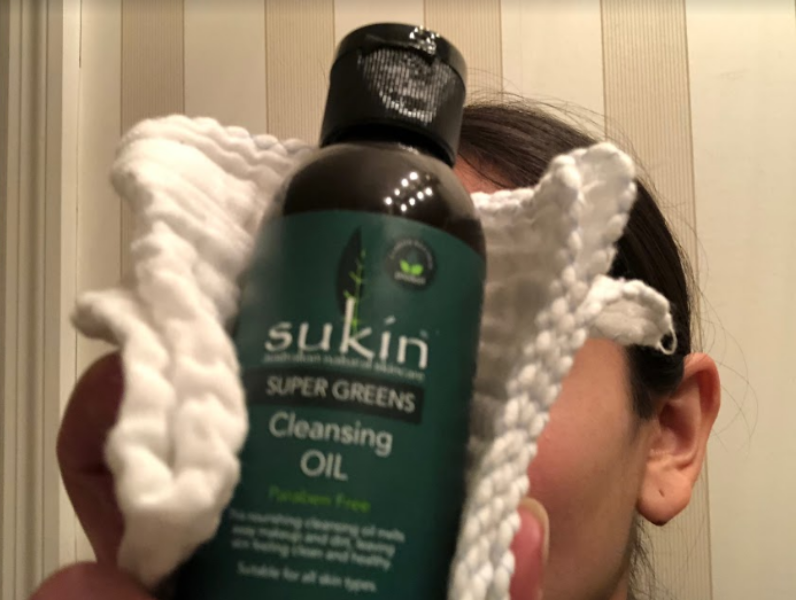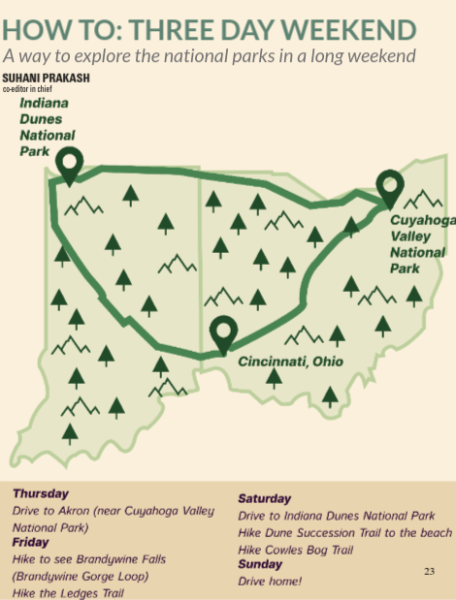Why I wash my face with oil
Oil-cleansing method offers meditative, unexpected skincare option
CLOTH AND OIL. The cleansing oil I use along with one of my muslin cloths. Oil-cleansing with a muslin cloth can also serve as a method of exfoliation, helping to keep skin smooth and clear of dead skin.
You spit into the sink, a combination of liquefied toothpaste and saliva pooling around the drain. After rinsing your mouth out with a few sips of water, you reach for the small bottle sitting on your sink, squeeze some oil into the palm of your hand, and rub it all over your face. Smile! You’re shiny.
It likely seems counterintuitive to use oil, a substance typically perceived as an enemy of skin—especially teenaged skin—to wash one’s face. But the oil-cleansing method is rising in the recommendations of dermatologists and wellness and beauty bloggers alike.
As board-certified dermatologist Dr. Jessica Weiser of New York Dermatology Group explained to Man Repeller, a fashion and lifestyle website, “Oil cleanses the skin by combining with the excess oils and debris on the skin surface, whether natural oils like sebum or oils found in skincare products and makeup.”
Current and past chemistry students may recognize this as a sort of “like dissolves like” property. The cleansing oil brings impurities to the surface of your skin.
Washing away the cleansing oil helps purify clogged pores and washes away excess sebum, dead skin, pollutants, makeup, and dirt without stripping skin as soap may. When used correctly, oils are soothing and protect natural skin lipids and good bacteria.
Weiser recommends using “lighter or more ‘watery’ consistency” oils for cleansing. While I am currently using a cleansing oil purchased on sale from Fresh Thyme, full-price high-quality oils and pre-combined mixtures of pure oil can be expensive.
For a simpler and more economical DIY option, beginners can start with a 1:1 ratio mixture of olive oil and castor oil, or pure grocery-store olive oil alone. Sweet almond oil, grapeseed oil, avocado oil, sunflower oil, apricot kernel oil, argan oil, and jojoba oil are all recommended additives.
You can oil-cleanse once a day or do it less frequently as a detox. Many recommend oil-cleansing at night since your skin is at its grimiest from a day of living life and to hydrate your skin for bed. Because it works best for my routine, I oil-cleanse in the morning and use a typical face wash at night.
Now comes the fun part. Squeeze a quarter-sized dividend of oil into your palm, rub your hands together, and then close your eyes and spend a few minutes massaging the oil onto your face. Your face should be oily enough that you are not tugging on your skin as you massage it with your hands.
Take this opportunity to breathe deeply, honor yourself, and live out that pipe dream of becoming a masseuse (or getting a massage). If you’re unsure of how exactly this massaging should play out, facial massage tutorials like this two-and-a-half-minute video can be found online.
If you’re a minimalist or pressed for time, the next step is simply to rinse your face thoroughly with warm water. Make sure that the water is warm to avoid leaving behind dirt and unwanted oils on the surface of your skin.
Pat your face dry with a towel and take note of how your skin feels—it should feel less tight and “thirsty” than after a typical soap cleansing.
For all of you self-indulgent, spa-loving maximalists, the next step involves a washcloth (I use these muslin cloths). Completely wet the cloth with warm water, then gently wring it out, uncurl it, and drape it on your face.
When the cloth no longer feels warm, rewet it and use the cloth to gently (this is not meant to be a completely skin-stripping step) wipe the oil off of your face using circular motions. Again, ensure that the water on the cloth is warm when it touches your skin.
That is all. Your skin should feel moisturized, but not oily. Depending on how hydrated your skin feels, you can still moisturize after oil-cleansing, especially if you used the washcloth method.
Oil cleansing is fun for you and for your skin. This happily oily girl wishes you happy cleansing.
Sources:
- https://www.healthline.com/health/oil-cleansing-method#1
- https://www.manrepeller.com/2018/11/oil-cleansing-best-skincare.html
- https://www.youtube.com/watch?v=fXdZe8cBuzA
- https://www.amazon.com/Karlling-Cotton-Facial-Cleansing-Muslin/dp/B00IBFC874/ref=pd_ys_sarp_4?_encoding=UTF8&pd_rd_i=B00IBFC874&pd_rd_r=B3ENVAHBN4Q0VCP66N2Q&pd_rd_w=Jfpuk&pd_rd_wg=RpkPi&pf_rd_p=8328b5cc-59f9-4b32-ade0-718c89672d9c&pf_rd_r=B3ENVAHBN4Q0VCP66N2Q&psc=1&refRID=B3ENVAHBN4Q0VCP66N2Q
- https://www.bustle.com/p/i-washed-my-face-with-olive-oil-for-2-weeks-im-going-to-keep-doing-it-2358941
Your donation will support the student journalists of Sycamore High School. Your contribution will allow us to purchase equipment and cover our annual website hosting costs.







